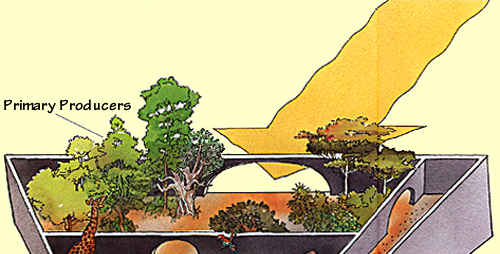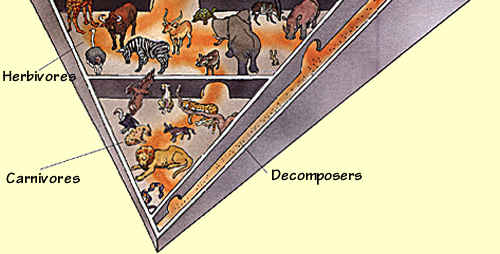|
| Energy flows
through each individual and indeed, through the whole carpet of life, one
way and downhill. All the energy that enters earth's biosphere eventually
goes out again, dispersed into outer space as heat. Along the way, however,
energy percolates through several "consumer" levels (symbolized as segregated
compartments below). |
| At
the first level, green plants (and photosynthetic bacteria) capture
the energy from sunlight and put it into the chemical bonds of sugar
- life's universal food - in the process called photosynthesis.
Plants make sugar for their own use, but they make enough of it
to support all other life as well. Herbivores (plant eaters) get
their sugar directly from plants, and carnivores (meat eaters) get
theirs from the flesh of herbivores. A fourth group, the "decomposers"
(i.e., mostly bacteria and fungi) get sugar by breaking down the
waste products and dead bodies of the other three groups. |
 |
| At
every level, organisms that cannot convert the sun's energy
are dependent on those that can. Here an amoeba eats a photosynthetic
bacterium. |
|
|
| Plants, then
(and incidentally, bacteria long before plants existed), are the vanguard
of life. We and all other animals are parasitic to plants. We could only
evolve after plant-made sugar (and oxygen, which is a waste product of sugar-making)
became plentiful on earth. In fact, we are triply indebted to plants: (1)
for our fuel, (2) for oxygen to burn it, and (3) for saving us from being
cooked by the effects of the carbon dioxide produced when we burn that fuel.
Carbon dioxide, accumulating in the atmosphere from life and from the industrial
processes we have invented, prevents heat from escaping the earth. Plants
consume that carbon dioxide in enormous quantities, thereby protecting us
from overheating. |
|
|
|






